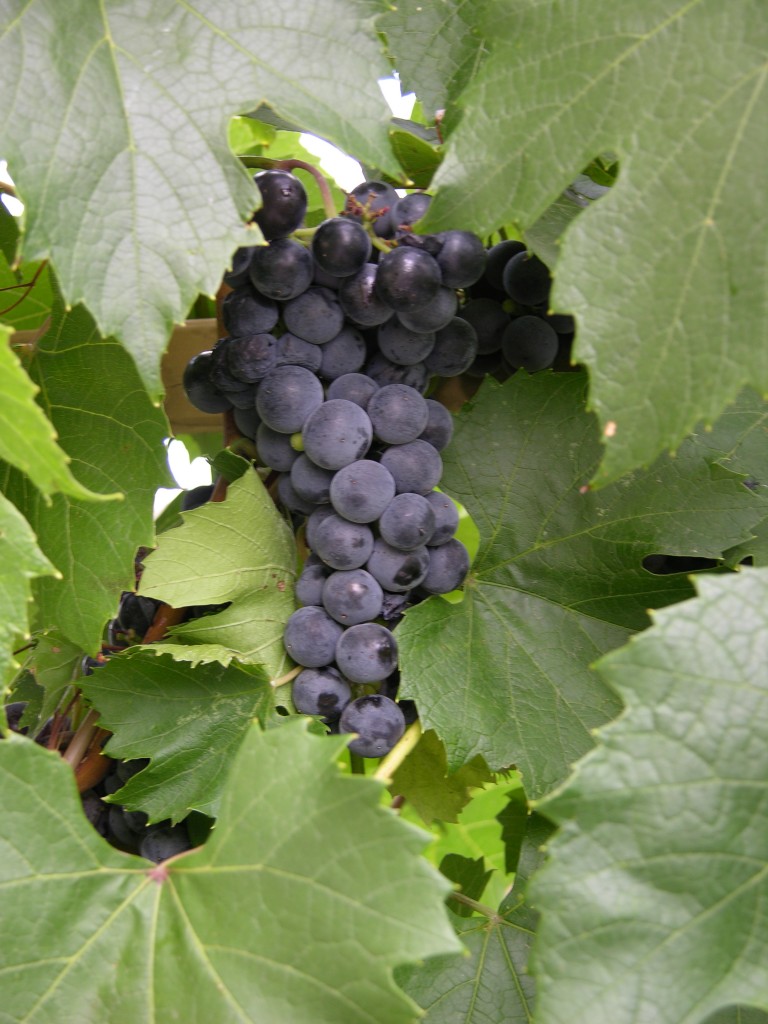Saint Theresa Seedless grape: glorious grape

Saint Theresa Seedless grape (Vitis x ‘St. Theresa Seedless’) is a superb new table grape for the Rocky Mountain region. This very hardy and mostly seedless (an occasional seed or two is discovered) purple grape offers an abundance of large clusters of sweet fruit in early September. There is plenty of time following the harvest for the plant to store energy for winter. The vine is vigorous and healthy, showing little concern for our alkaline soil conditions. This is an exceptional selection bred by Elmer Swenson of Osceola, Wisconsin, renowned for breeding many selections of cold hardy grapes. Saint Theresa Seedless grape has notable grapes such as Concord and Thompson Seedless in its lineage.
This wonderful, versatile vine was named in honor of Saint Theresa of Lisieux, France, the Carmelite Nun who showed her love of God by planting flowers. She is the patron Saint of many, and of the local cities of Pueblo, Colorado and Cheyenne, Wyoming.
View the plant profile here.
St. Theresa Seedless Grape (Vitis x ‘St. Theresa Seedless’)
Woody Vine
Height: 15-20 feet
Width: 3-8 feet
Blooms: Inconspicuous
Sun: Full sun to partial shade
Soil Moisture: Moderate
Hardiness: USDA zones 4-9
Culture: Garden loam
Thanks to Scott Skogerboe, Fort Collins Wholesale Nursery, for writing this piece.



Question: My St Theresa grapes have been in 5 years now and are huge. I only put up a 5′ trellis so am trying to get them to grow out instead of up. The leaves taste great. I prune it severely in May, but it is so prolific that the grapes are small and sour. I leave them for the birds. Should I prune it all summer to try and contain it? Should I try for fewer bunches of grapes to see if they’ll grow larger? Thanks for the help!
From Scott Skogerboe… sounds like you need to thin out some of the clusters: “I’d suggest you leave every leaf alone and continue cutting out the fruit clusters until they are to the size you want. Give them plenty of water, but once a week deeply is enough – roots need air as much as they do water. Water-logged soil can cause decrease in plant health, even death. Fertilizer is great until the middle of August but then stop so as to allow the grape plant enough time to prepare itself for winter. Pruning off lateral branches encourages terminal growth if you want a tall vine, but lateral branches have lots off leaves which produce carbohydrates through the process of photosythesis, so you have to make a personal judgement. Winter watering on warmer days during times of little to no snow cover is also critical.”
I was about to give up on these – tons of grapes, very sour – but then we had a light frost and they immediately sweetened up. I will try thinning next year (thanks for that suggestion, Pat!) as the grapes were on the small side but oh so abundant.
A ratio around 12 fully grown (large) leafs per 1 cluster of grapes should be sufficient for full maturation of the berries at harvest.
You’ll need to use netting for the birds and leaving fruit on the vine for longer will help with the “sourness” of the grapes.
Are ‘Saint Theresa’ grapes grafted?
No, they are on their own root. Enjoy!
Excited to have a bumper crop this year. Know the two of us will not eat all. Are they good for jam or jelly? Also saw a comment about using leaves. what do you use the leaves for?
Greeks typically make stuffed wraps with grape leaves called dolmathakia. They are quite good and there are recipes online.
I made a wonderful jam with these this year, as well as an unsweetened juice, which we froze in ice cube trays. One thing I did not try is making raisins with them. The Reliance made wonderful raisins!
I have 6 pounds of incredibly sweet grapes from our one large vine which is about 18′ long spread over a south facing pergola in our backyard. Care to share your jam recipe? My wife has an online and market Eastern European bakery business and freshly made grape jam sound like a great match! 🙂 …Michael
My vine is a mass producer. Small tasty grapes that makes a fabulous jam.
Enough grapes for 6 cups of juice with a food mill. 4 cups of sugar. 1/2 cup pectin. Makes 4 pints of jam.
I live in Denver, Colorado (zone 5A), my St. Theresa plants have not started leafing out as of 5/1/2020. How do I know if they died over the winter?
Give them just a little more time. They should be fine. The late freeze could have set back the leaves from emerging.
Where can I purchase this grape variety in Colorado Springs? If not there, then in Denver?
There are several places that carry it and if they are sold out they can get it. Follow this linkFollow this link and sort by city and you’ll have all of their phone numbers. Enjoy!
Heidrich Nursery has St Theresa grapes – I just stopped by there yesterday.
My St Theresa grape is several years old and I’ve had enough grapes the past 2 years to make jelly! This year, it started getting buds like normal, but now the emerging leaves look all shriveled and distorted. Yikes! What is wrong and what do I do?
could be aphids or possibly eriophyid mites. If it is aphids try to wash them out with a gentle, yet forceful. That will help. If it is eriophyid mites, they are hard to get rid of and spray is out of the question since you’re going to eat the grapes. Keep the plant well watered and fertilize. The eriophyid mite infestation changes from year to year and maybe next year they won’t be there.
I’d love to plant this but wonder how susceptible it is to Japanese Beetle–do you have any experience in this area?
I’ve noticed that some of my roses are less susceptible to the beetles than others, and wonder if that’s the same with other plants that tend to be attractive to them.
This is the second year of my St. Theresa’s. They are growing horizontal about four feet off the ground and 20 foot spread.
Dozens of nice clusters just starting to turn purple. Japanese Beetles have discovered them, just appearing one day out of
nowhere. They can devastate a grape plant in no time. I’ve been hand picking them off the plant and have destroyed over 350
of them. New growth has kept ahead of them so I have a crop. They so far have only eaten the leafs, not the grapes,.I have a
second grape plant that is 6 years old of unknown type.
Produces much larger grape/clusters and a large crop this year. Leafs are a much darker green than the St. T. About two weeks
behind the St. T’s in ripening. The Beetles much prefer the St.T’s
Hi, I bought the awesome Pretty Tough plants book I live elevation of 6300 and was super excited to see a vine that may grow. The other day we ere expected to get 2 feet of snow. So I covered them all. And that they were all ok. Because it was warm the next day I assumed it was ok to take all the protection off. But last night the tempurature was colder than expected and the vines I had just recently put in got completely wilted. I can’t afford to buy more from Fort Collins Nursery what can I do to revive them. Please help
These plants should rebound after the cold. Give it some time and I bet your grapevine will leaf out again, but may not produce fruit this year.
I have brand new St. Theresa Grape. They were planted early summer 2022. They went into dormancy nicely this winter. I’ve looked up how to prune and care for them but I don’t understand what it means to “cut back each cane to one or two buds from last years growth”. Can someone give me a simple version of what I should do year 1, year 2 and year 3. My instinct is to just cut down to the ground if “flowers and fruit appear on new growth”. I think I’m missing something and any help is appreciated.
Bridget, GREAT QUESTION! It is challenging to count back years on woody plants, but with practice, you’ll find it becomes easier. Grapes can grow 5′ in a year, so you have to look closely at the stem for a long distance. Imagine following a creek high in the mountains down to the planes. Many other creeks join the one you started, but at some point, you realize the creek is more like a river. That is kind of like following the grapevine back, there will be a point where the bark looks older and the girth of the branch is wider. That is the end point of “last year’s growth”. Count back 2-3 more buds down the stem and cut. Keep doing that each year, and you’ll train your grapevine to develop a nice, thick trunk that will produce lots of fruit on new growth each year and that is easy to harvest at a height you can manage. One last note-increase watering while plant is blooming and growing fruit then
harvest fruit in the fall just after first frost or when temperatures really drop. The grapes will taste GREAT!
We’ve had a St. Teresa grape plant for several years now. (maybe 4) Last year was the first time we got any grapes. We got just a few small clusters. This year I still have not seen a bloom. I fertilized it in the spring with 22-24-12 and I cut it back last winter. What do I need to do to get grapes?
Don’t cut it back hard this winter. Trim wild branches back to the trunk. You should get grapes next year if the weather isn’t too crazy.
What is a good trellis system for this grape? Modified Munson or VSP maybe?
Do these want to be Spur pruned or Cane pruned?
Good question. Cane pruning so that the plant forms a trunk is best.